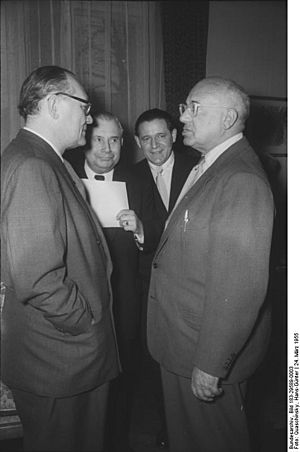Rudolf Wagner-Régeny facts for kids
Rudolf Wagner-Régeny was a talented composer, conductor, and pianist. He was born on August 28, 1903, in a place called Szászrégen, which was then part of the Austro-Hungarian Empire. Today, this town is known as Reghin and is in Romania. Rudolf Wagner-Régeny passed away on September 18, 1969, in Berlin. He became a German citizen in 1930 and later an East German citizen after 1945.
Contents
Early Life and Musical Training
Rudolf Wagner-Régeny began his musical journey by studying at the Leipzig Conservatory from 1919 to 1920. After that, in 1920, he joined the Berlin Hochschule für Musik. There, he learned how to conduct music from teachers like Rudolf Krasselt and Siegfried Ochs. He also studied how to arrange music for orchestras with Emil von Řezníček. For composing music, his teachers were Friedrich Koch and Franz Schreker. He finished his studies in 1923.
First Jobs in Music
After graduating, Wagner-Régeny worked as a choirmaster at the Volksoper Berlin from 1923 to 1925. A choirmaster is someone who leads a choir. In 1927, he joined Rudolf Laban's dance company. For three years, he conducted music for their dance shows.
Becoming a Well-Known Composer
Rudolf Wagner-Régeny first became known for the music he wrote for plays in a city called Essen. In 1929, he met a designer named Caspar Neher. Caspar Neher wrote the stories, called librettos, for many of Wagner-Régeny's most famous operas. An opera is a play where most of the words are sung.
Challenges During the War Years
In 1930, Wagner-Régeny became a German citizen. He also got married. During the time when the Nazis were in power, his music was sometimes seen as similar to that of Kurt Weill, whose music was not approved by the Nazis. However, some people in the Nazi party actually supported Wagner-Régeny. He even became friends with Baldur von Schirach, a powerful figure. His works were performed by famous conductors like Karl Böhm and Herbert von Karajan.
His opera Der Günstling was very successful when it premiered in 1935. But later, another opera, Johanna Balk, caused problems in 1941. This made Joseph Goebbels, a high-ranking Nazi official, very angry. As a result, Wagner-Régeny was made to join the military in 1942 or 1943. Luckily, he was able to get a desk job in the army, which helped him survive the war.
Life After World War II
After World War II ended, Rudolf Wagner-Régeny chose to live in East Germany. From 1947 to 1950, he was the director of the Rostock Hochschule für Musik. In 1950, he became a professor of composition at the Berlin Hochschule für Musik and at the Academy of Arts. He taught there until 1968, when he became too ill to continue.
His Unique Musical Style
As a composer, Wagner-Régeny wrote many different kinds of music. He created symphonies, which are large pieces for orchestras, and chamber music, which is for smaller groups of instruments. He wrote 12 operas. Some of his best-known operas include Die Bürger von Calais (1936), Johanna Balk (1938), Das Bergwerk zu Falun (1958), and Prometheus (1959). His ballet Tristan (1958) is also highly praised.
Wagner-Régeny worked hard to create his own musical style. He wanted his music to be modern but not connected to the ideas of fascism. Early in his career, he was inspired by composers like Ferruccio Busoni, Kurt Weill, and Arnold Schoenberg. His collaborations with Caspar Neher and Bertolt Brecht also helped shape his style. In 1950, he started using a special way of composing called the twelve-tone serial technique. His stage works often had a clear and simple sound, similar to the music of Weill and Hanns Eisler.
Main Musical Works
Rudolf Wagner-Régeny composed a variety of works, including operas, orchestral pieces, and vocal music.
Stage Works (Operas and Ballets)
- Moschopuls (1928)
- Der nackte König (1928)
- Sganarelle or Der Schein trügt (1929)
- La sainte courtisane (1930)
- Der Günstling (1935)
- Die Bürger von Calais (1939)
- Johanna Balk (1941)
- Prometheus (1959)
- Das Bergwerk zu Falun (1961)
- Persische Episoden (1963)
Instrumental Music
- Orchestral music with piano (1935)
- String quartet (1948)
- Two dances for Palucca (1950)
- Three orchestral pieces: Mythological Figures (1951)
- Three orchestral sets (1952)
- Seven fugues (1953)
- Introduction and ode for symphonic orchestra (1967)
Vocal Music
- 10 Lieder (songs) based on texts by Brecht (1950)
- Cantata “Genesis” (1956)
- Jüdische Chronik (1961)
- Hermann Hesse songs "Gesänge des Abschieds" (1968/69)
- Three Fontane-Lieder (1969)
Sources
- David Drew. The New Grove Dictionary of Opera, edited by Stanley Sadie (1992), ISBN: 0-333-73432-7 and ISBN: 1-56159-228-5
- The American Symphony Orchestra will perform the US Premiere of Mythological Figures (1951) in 2009 [1]
See also
 In Spanish: Rudolf Wagner-Régeny para niños
In Spanish: Rudolf Wagner-Régeny para niños


